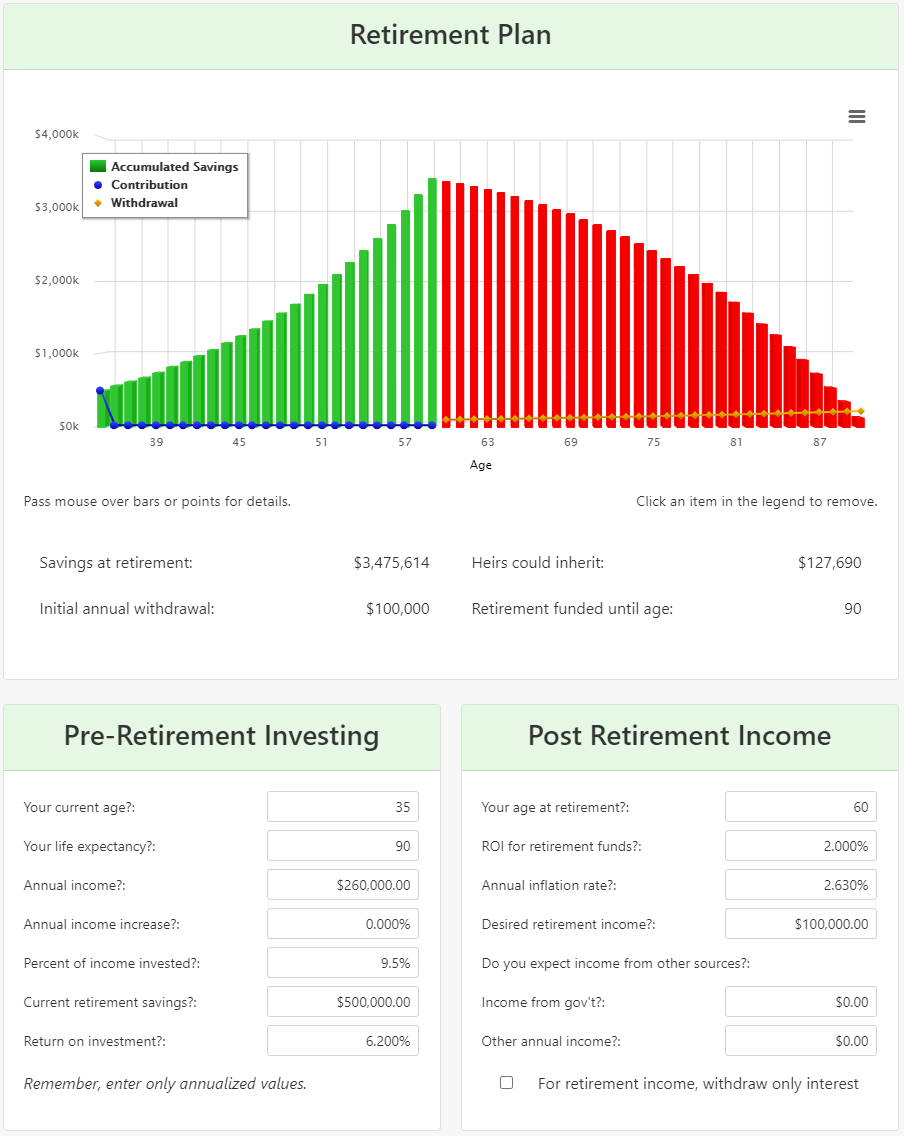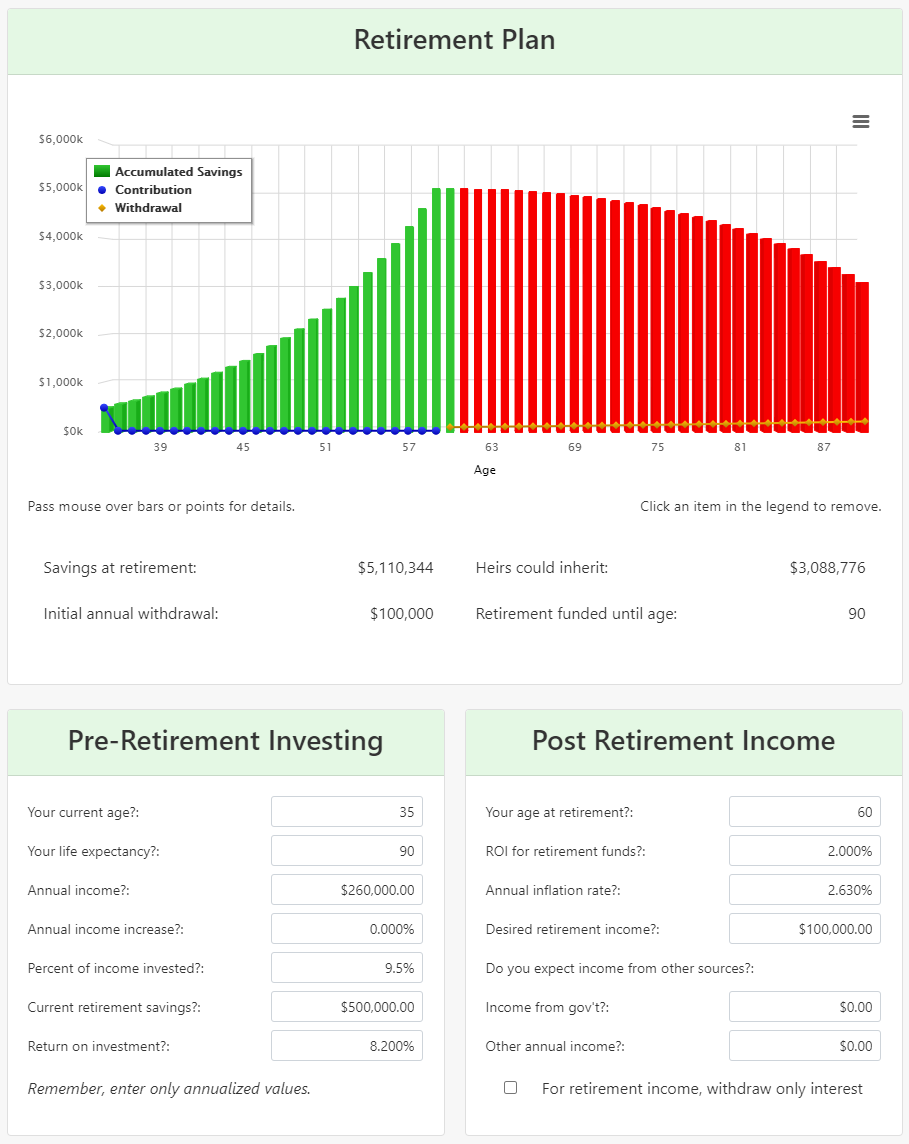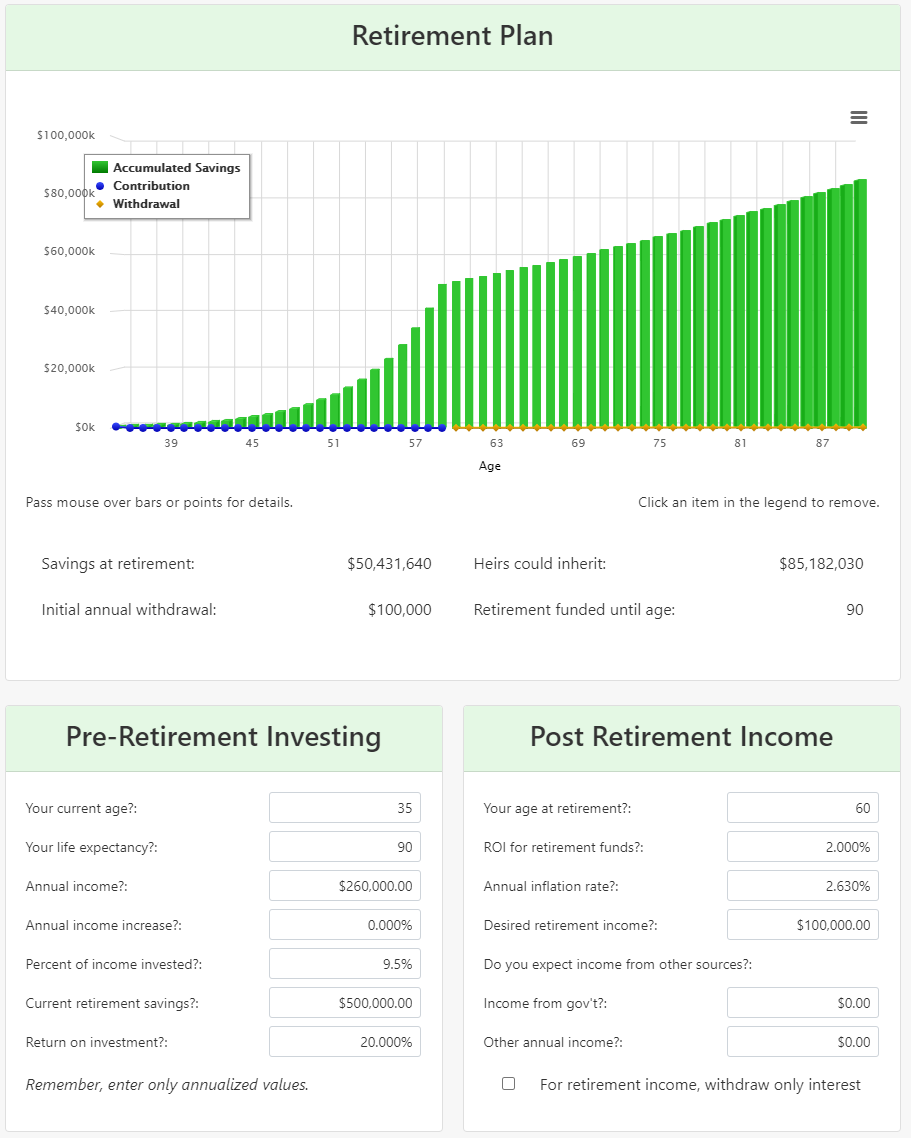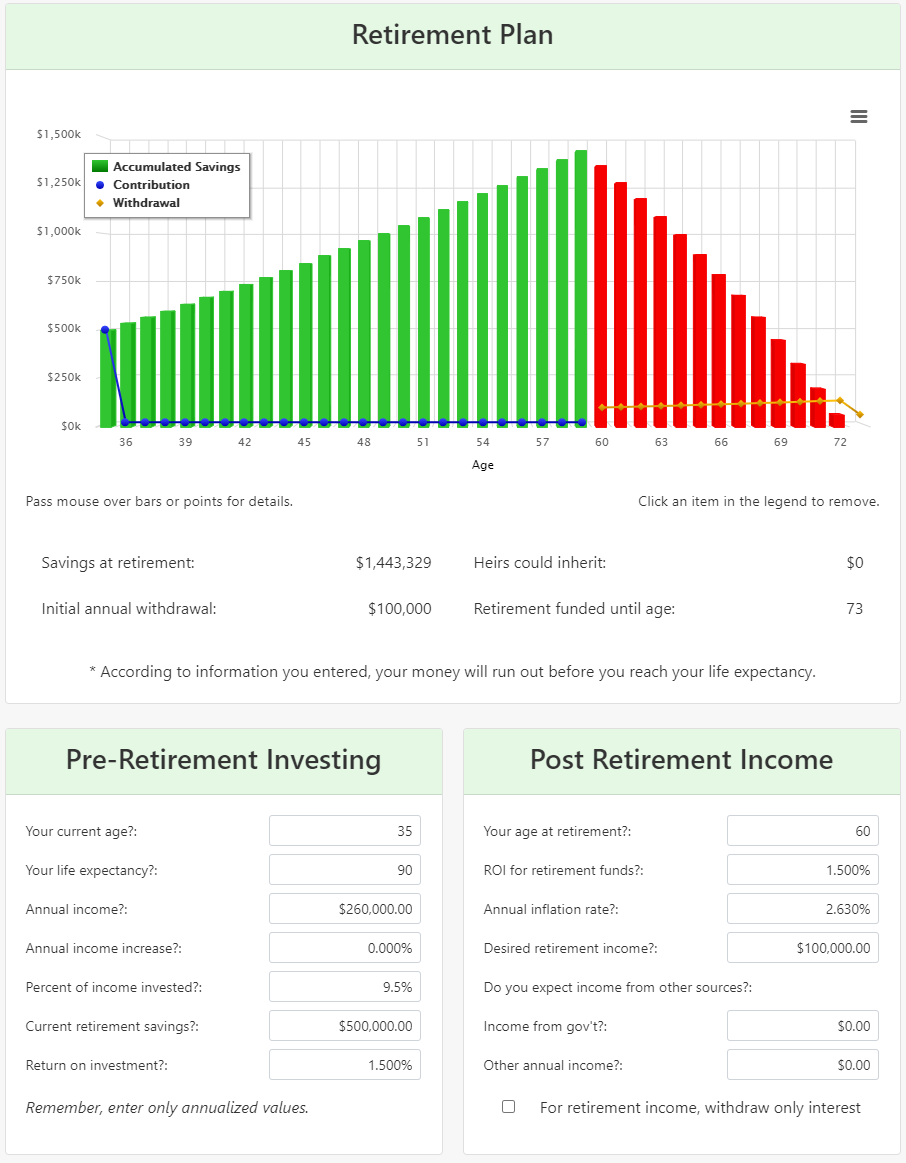Superannuation, Self Managed Super Funds, Investments, Calculators & Tools - Log in / Sign up View My List.
Superannuation, Self Managed Super Funds, Investments, Calculators & Tools - Log in / Sign up View My List.
Calculators & Tools
 Gareth Lane
Gareth Lane
Updated Dec 19, 2022
Mate Checked
This information has been reviewed by our SMSF Mates before it was published as part of our review process.
Knowing how much you need in Super by the time you retire is critically important before planning out your retirement and associated investment strategies.
There is no excuse for not making it a priority when you are young as you have time on your side and hopefully this article outlines what a monumental difference having a handle on your investments can make.
Rather than paying a Financial Planner thousands of dollars to create scenarios for you, we’ve outlined out retirement plans in three scenarios
Jump to a specific part of this page:
This one is fairly obvious and the sooner you start thinking about your retirement, the easier it will be to look at Superannuation investment opportunities.
Gareth is 35 so the scenario is based on him.
This one is really important as it moves the needle a lot. For me, I have a fairly non physical job, not really at any risk of dying on the job unless my keyboard and my grandparents lived to 90+.
Living in Australia, the official stats say the life expectancy is 82.50 so I can only assume that I should have a high chance of hitting that.
Gareth went with 90 as the target life expectancy.
This one doesn’t make as much of a difference as you think. Its really only used to calculate the contributions to super in percentage terms. In Australia all individuals are entitled to a $25,000 superannuation contribution limit and a compulsory 9.5% from your employer.
Thus we have used an annual income of $260,000 as $260,000 x 9.5% = $24,700 contribution to super each year.
The annual income increase box can move the needle substantially as it will adjust the superannuation contribution of which we Australians are limited to keep things easy to follow, we’ve assumed no pay rises until retirement. Or you could look at it as being able to contribute $24,700 per annum to super until age 60.
The percent of income invested we have assumed 9.5% which is the current compulsory superannuation contribution for employed Australians. We have however ‘modified’ the numbers to take advantage of the $25,000 tax concession.
We have assumed a starting balance of $500,000 AUD
Gareth has an optimistic dream of being able to retire at age 60 like many baby boomers however the realistic fact for many Australians is working until much later in life. However for the sake of the examples, we’ve gone with age 60.
ROI stands for Return on Investment. The ROI for Retirement Funds is the expected performance of your superannuation investments from retirement to end of life. For the sake of the examples, we have assumed that your investments will revert to cash from when you retire.
Obviously if you can achieve risk free investments at better than 2% through retirement, you will have more to spend.
This number is really important and often forgotten. This helps to understand the time value of money and how inflation can easily eat into investment returns. In theory you should also have your funds invested where you can achieve at least the inflation rate or better.
Read more about how Inflation affects investment returns here.
Another major needle mover, how much income you need in retirement will greatly affect the amount of money you need at retirement. Much of the internet suggests that you should need around two thirds of your pre retirement income to maintain the same standard of living in Australia.
Gareth is used to niceish cars, an international holiday once a year and an expensive wine habit so we’ve assumed a bit more. Still not ridiculous but a bit more than the suggested averages from AFSA (see table below)
| ASFA Retirement Standard | Annual living costs | Weekly living costs |
| Couple — comfortable | $62,269 | $1,193 |
| Single — comfortable | $44,146 | $846 |
| Couple — modest | $40,560 | $777 |
| Single — modest | $28,165 | $540 |
Source: ASFA Retirement Standard, December quarter 2019
Income from Government
This part of the calculator assumes you can access government benefits like the pension. For the sake of the example, we have assumed you do not access any income from government sources.
Other annual income
This part of the calculator assumes you will receive additional income through retirement such as a part time job, inheritance or gifts. For the sake of the example, we have assumed you do not receive any of these benefits.
Important Note, the calculator DOES NOT take into account tax.
Learn more about how Tax effects Superannuation Returns here
The return on investment achieved by your super fund is what moves the needle the most.
Remember all scenarios do not account for taxation or major unplanned events. Thus its best to over estimate your requirements.
In this scenario we have assumed Gareth has left his superannuation in a typical balanced super fund and not paid much attention to it.
We can see that in this scenario, all the numbers work out, he is able to self fund his retirement and withdraw $100,000 per annum (pre tax) up until the age of 90 with a little left over at the end.
Scroll down to see what happens if we get a boost in performance.

In this scenario, every number is exactly the same, except for one crucial difference.
Please be clear, we have not suggested changing the superannuation investment allocation.
Simply
And look at the difference! An extra $3,000,000 at the end of retirement! Or an extra $50,000 per year for 30 years through retirement!
Read on to see how the best in the business can do.

In this scenario, every number is exactly the same as the previous two examples except for return on investment.
In this example, we’ve assumed you’re at the top of your game and can consistently, keyword consistently, achieve 20% returns for 30 years.
This one really illustrates the power of compound interest. Of course we would all want to achieve 20% per year for the rest of our lives but the probability of doing so is slim.
Now scroll down to see the opposite, sitting your funds in cash.

Every number stays the same again, but this time the return on investment is based on cash.
Cash rates have been dropping every year in Australia and are all at time lows. Current term deposits are sitting at around 1.5%
This becomes dangerous territory for self funded retirees due to the annual inflation rate being higher than the cash rate.
In this scenario, assuming the same level of retirement income, the cash runs out at age 73.
Expect to live to 90 and you’ll need to reduce your annual income to around $40,000 to make it to the end.

It is my opinion that a self managed super fund is the key to getting a slightly better return which translates into an enormous difference in retirement.
Yes there are costs and hassle associated with a self managed super fund but the primary benefit of being able to time the investment allocation and invest in better opportunities without fees really does make a big difference down the line.
Just think about it this way, an extra $50,000/year for the life of your retirement is worth spending a day a month on your investments right?!
General Advice WarningGareth Lane is a successful entrepreneur, businessman, and owner of the digital marketing and web agency Concise Digital, based out of Perth, Western Australia. Concise Digital have solved over 60,000 digital / web problems for clients since 2005. Gareth is one of the founders of SMSF Mate.
Gareth is passionate about helping small businesses be more successful online by avoiding the pitfalls of digital marketing. He regularly runs live talks, workshops and meetups discussing Google, social media and all things digital marketing.
Gareth studied Business and Commerce at Curtin University, and has held board positions for a number of organisations, including serving as the President of the Western Suburbs Business Association and as a non-executive member of WA Business Assist. A true entrepreneur at heart, he started his first business at 13 and has created and run multiple successful businesses since.
Gareth enjoys good food, great wine and time in the sun when he’s not at his computer helping other businesses get ahead!
You can find out more about Gareth or connect with him on Linkedin here: https://www.linkedin.com/in/garethconcise/
Or visit his websites here: https://www.concise.digital/ or https://www.garethlane.com/
SMSF Mate is a unique website because it has ideas about how to approach SMSFs, insurance and other financial topics that come straight from first hand experience. It's much more useful than what you find on all the other financial websites that just offer generic info that you could easily get on the ATO's website. It's also nice to know there's no financial incentive behind the information, it's legitimately there to help people understand self-managed super funds and how to get the most out of them, not to get an affiliate commission from a broker or other financial services provider. The investment product information is also incredibly useful, I've never seen this kind of functionality on any other website that let's you look at such a wide range of products, sort by what info is most interesting or important to you, and subscribe to updates for different funds and financial products all in one place. Definitely worth checking out if you own or are considering an SMSF!
SMSF Mate provides a unique insight into superannuation and financial topics in a way that is easier to understand than conventional websites. The colloquial nature of the site makes it easy to understand and they often speak about complicated topics in lamens terms so I can wrap my head around them. The investment product information is a great way to research funds that I am interested in investing in with my SMSF and there is a lot of helpful information on the site for better structuring my investment portfolio. In comparison to other websites which offer similar information, SMSF Mate excels as the information is free to access whereas many other sites charge a subscription fee for the same thing. Overall, I think SMSF Mate is a great resource for SMSF trustees and is worth looking at for a variety of super-related topics. Thanks.